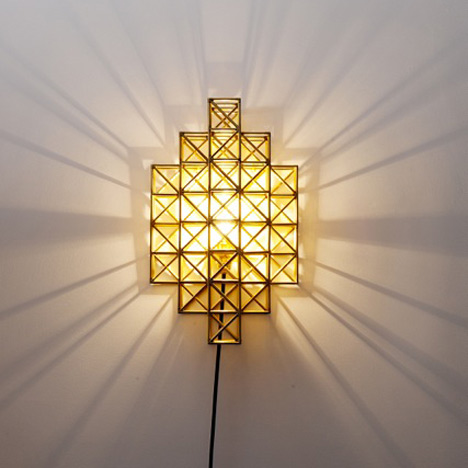
Gridlock 2 by Philippe Malouin
The latest collection by London designer Philippe Malouin combines concrete with a complex brass grid.
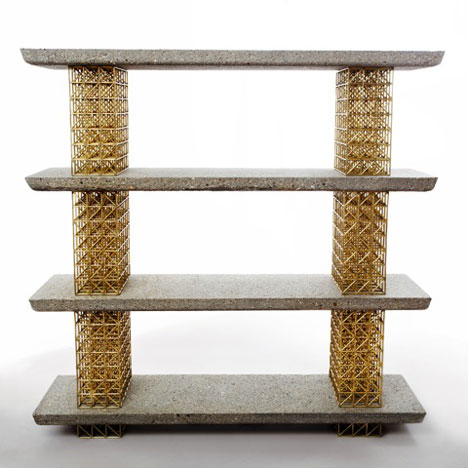
An extension of his earlier Gridlock project, the pieces are made entirely by hand.
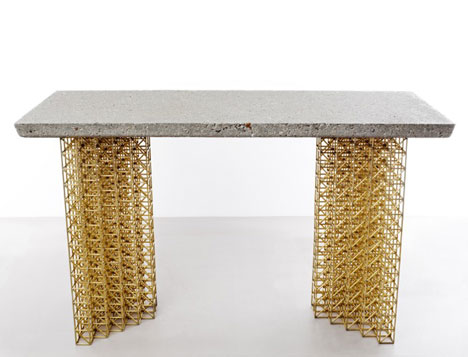
The new work is on show at NextLevel Galerie in Paris until 14 January.
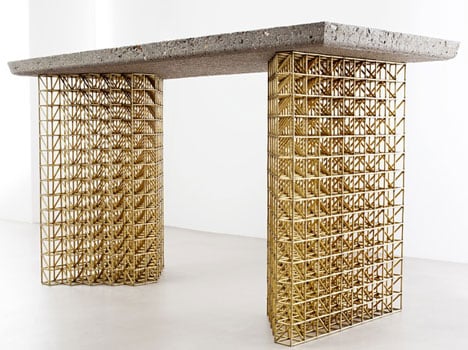
See all our stories about Philippe Malouin here.
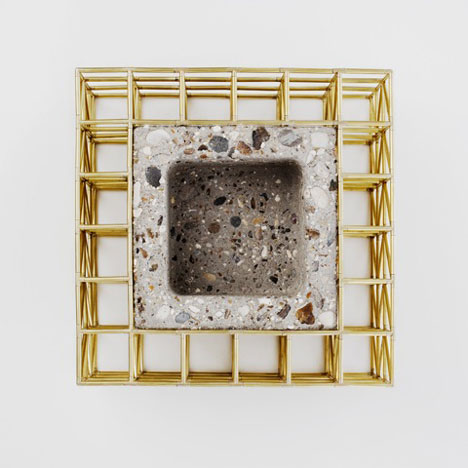
Photographs are by Alexandra B.
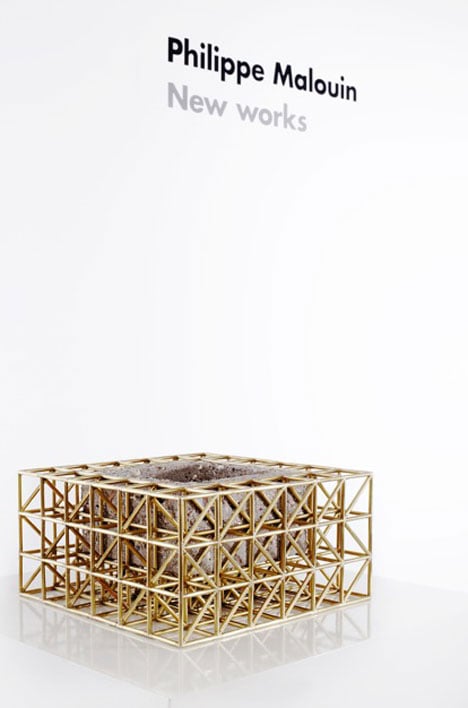
Here are some more details from Malouin:
NextLevel Galerie, Paris, on show until January 14th 2012
Foreword by Will Wiles.
Brutalism’s name is a gift to its detractors. It conjures architecture that is somehow brutish: buildings that are aggressive and inhumane. The stark, primal forms of brutalist architecture and its rough, unadorned surfaces don’t immediately help dispel this impression. But brutalism is possibly the most sensual architectural style there is – or at least the most tactile, the most attuned to touch and feeling. Its raw, exposed concrete surfaces – the béton brut that first gave the style its name – invite touch. Your touch is rewarded with a surprising variety of textures from a that is so often derided as sombre and monotone. Poured, it can be as smooth, dense and cool as marble. Or it can take on the surface qualities of whatever formwork is used to shape it. I remember first seeing the wood grain on the shuttered concrete of the National Theatre in London – my first instinct was to run my fingertips across it.
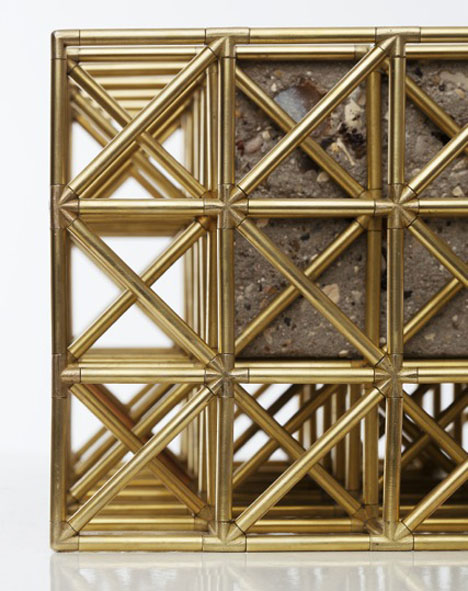
This same invitation to touch applies to the concrete surfaces that are the new addition to Philippe Malouin's Gridlock range of furniture. Concrete has been used for furniture before, most famously Ron Arad’s Concrete Stereo. But Arad’s stereo was post-modern, post-industrial kitsch, exaggerating its own weight, cracking under it to reveal the rusting rebar underneath. Gridlock revels in its modernism, and with the glittering lattices that are the material heart of the range, the concrete is rendered almost weightless.

It's still the brassy grid that takes the eye, of course – in the light scattering through the structure of the Svetko chandelier, an inverted pyramid like Stefan Svetko's office for Slovak radio in Bratislava, and in the intriguing moire patterns that gather in the depths of the supports of the Scapa desk. But what the addition of the concrete slabs brings is this touch, a tactility that the materially sparing grid itself never quite had.
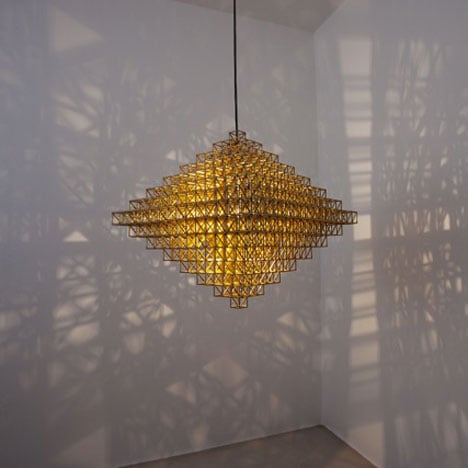
The way the grids express large architectural volumes with minimal matter makes it clear why they appealed so much to the utopian designers of the 20th century – architects and engineers such as Buckminster Fuller, Cedric Price and Yona Friedman. With space frames and geodesic domes, these designers took the modular, repeatable nature of metal framed structures and extended them outwards to their logical conclusion, proposing vast, city-enclosing megastructures. The addition of the concrete surfaces also makes the range's debt to the architecture of the 1960s and 1970s more obvious. It's an entirely conscious aesthetic strategy – and it's partly autobiographical. Malouin was born in Montreal, Canada, but lives and works in London. Both cities have particularly fine collections of modernist and brutalist architecture, and it's this shared heritage that Malouin wanted to emphasise. As preparation for the new Gridlock series, Malouin toured London's brutalist highlights with studio colleague Will Yates, lingering particularly at the Barbican Centre and the Golden Lane Estate, the closest the city has to a fully developed megastructure. the curved lip of the Barbican balconies can be seen at the edge of the Powell shelves, which take their name from one of the centre's architects, Geoffrey Powell of Chamberlin, Powell and Bon.
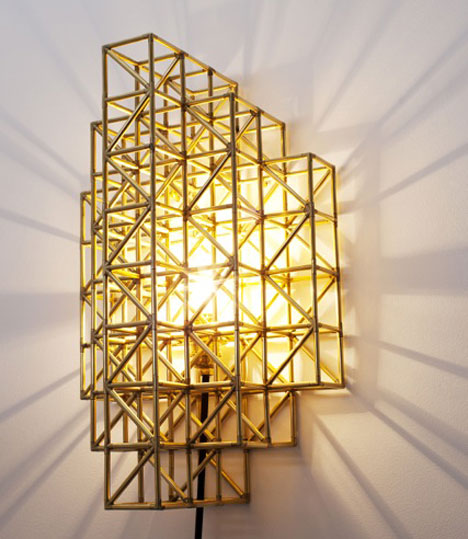
But while Gridlock feels industrial – in its straightforward, platonic forms and the repetitive efficiency of the grid – it is in fact assembled entirely by hand. Malouin's tribute to the industry-inspired, labour-saving dreams of modernism is paid for in toil. This paradox appeals to the designer – he likes things that are handmade that don't look handmade, such as geometric Yachiyo rug in chainmail. Malouin's practice is based on experimentation – he doesn't use a material that he hasn't got to grips with directly and played with, or tested to destruction, to explore its properties. His projects emerge from these explorations. They have a thoroughness and care built into them at the lowest level, while still expressing the automated, machined dreams of the modernist flowering.